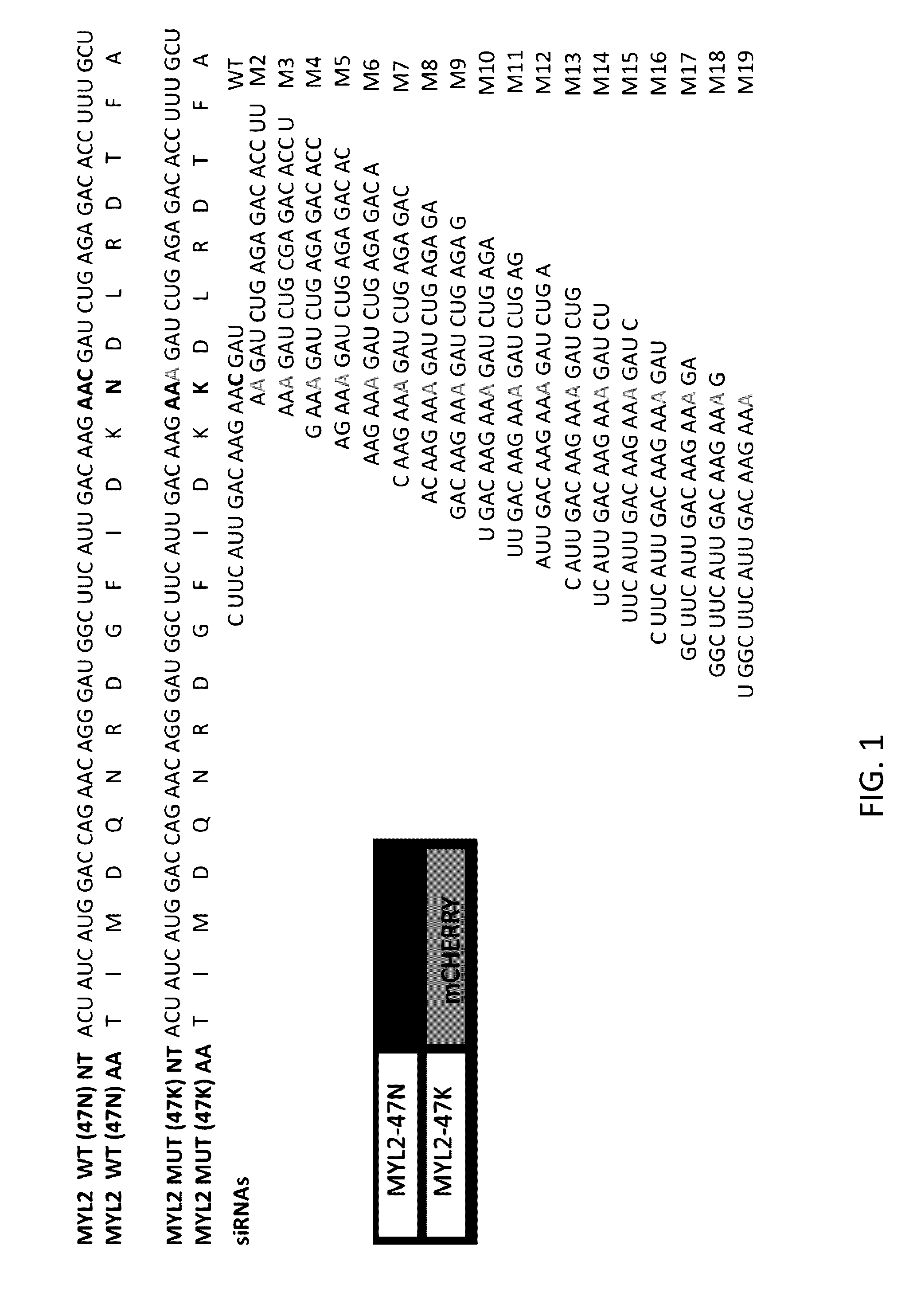Oligonucleotides and Methods for Treatment of Cardiomyopathy Using RNA Interference
a technology of oligonucleotides and cardiomyopathy, applied in the field of compositions and methods for treating cardiomyopathy using rna interference, can solve the problems of modest effects and often limited
- Summary
- Abstract
- Description
- Claims
- Application Information
AI Technical Summary
Benefits of technology
Problems solved by technology
Method used
Image
Examples
example 1
Oligonucleotide Therapeutic Approaches for Allele Silencing of HRLC-47K and HMHC-403Q Mutations in Hypertrophic Cardiomyopathy
[0188]We hypothesized that the delivery of oligonucleotides reagents with allele-specific silencing capabilities might abrogate the negative effects of the disease hypertrophic cardiomyopathy. We focused on silencing the alleles of two mutations: R403Q and N47K of the β-MHC and RLC, respectively. The R403Q mutation alters the binding between the myosin head domain with actin causing a lack of Z-line sarcomeric alignment and as consequence variations in myocyte shape and contractile failure. The R403Q allele is a “gain of function” mutation based on single molecule studies showing increased generation of force and faster actin filament sliding. On the other hand, the RLC N47K mutation affects the rotation of the lever arm. This rotation is important to create a large angle to replace the myosin head in a different position on the actin protein domain and gener...
example 2
[0248]To be described now is another experiment that addressed hypertrophic cardiomyopathy (HCM). HCM is a genetic disease of the heart muscle and the most common cause of sudden death in young people and athletes. It is caused by heterozygotic missense mutations in genes encoding proteins of the cardiac sarcomere.
[0249]Here, we present ex vivo and in vivo data for mutant allele-specific gene silencing of the N47K mutation of the regulatory light chain (RLC) according to an embodiment of the present invention. We have designed and identified an RNA interference (RNAi) construct, M7.8L, that reduced the expression of the mutated human regulatory light chain (RLC) by 45% in neonatal cardiomyocytes (NCM) and the expression of the wild type allele by 10%.
[0250]In an embodiment, Sarcomeric organization was induced with biomechanical devices to measure mechanical function of the NCM cells treated with M7.8L, which led to significant reduction in the beating rate, while sarcomeric shorteni...
example 3
[0322]To be discussed now is another experiment relating to induced pluripotent stem cells (iPSCs) that can be an important model system. When derived from patients, iPSCs provide a genetically matched system for drug development and discovery. Using previously described iPSC to cardiomyocyte differentiation protocols, we have used iPSC-derived cardiomyocytes to show that our gene silencing techniques can prove to be effective at silencing a mutant allele in a human model of hypertrophic cardiomyopathy. We attempted to silence a mutant allele of MYH7 using virally delivered shRNAs.
Silencing the R403Q Mutation Using Virally Delivered shRNAs
[0323]shRNAs targeting the R403Q mutation in MYH7 were designed and packaged into AAV6 viral vectors. The targeting shRNA sequence included sense and antisense targeting sequences separated by a HindIII restriction site: 5′-caccgGCCTCCCTCAGGTGAAAGTgaagcttgACTTTCACCTGAGGGAGGCtttt-3′. Differentiated iPSC-cardiomyocytes heterozygous for the R403Q muta...
PUM
| Property | Measurement | Unit |
|---|---|---|
| Fraction | aaaaa | aaaaa |
| Acidity | aaaaa | aaaaa |
| Therapeutic | aaaaa | aaaaa |
Abstract
Description
Claims
Application Information
 Login to View More
Login to View More - R&D
- Intellectual Property
- Life Sciences
- Materials
- Tech Scout
- Unparalleled Data Quality
- Higher Quality Content
- 60% Fewer Hallucinations
Browse by: Latest US Patents, China's latest patents, Technical Efficacy Thesaurus, Application Domain, Technology Topic, Popular Technical Reports.
© 2025 PatSnap. All rights reserved.Legal|Privacy policy|Modern Slavery Act Transparency Statement|Sitemap|About US| Contact US: help@patsnap.com



